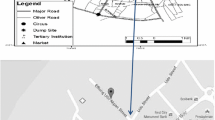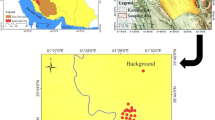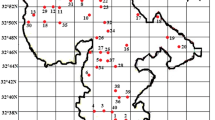Abstract
This study was carried out to determine the concentrations of heavy metals in the soil samples collected from an abandoned lead acid battery (LAB) industrial waste dumpsite in Ibadan, southwestern Nigeria. This was to assess the potential risks of the heavy metals on human due to exposure among local residents (children and adults) of the area. Forty (40) soil samples were collected over the entire dumpsite at 0–20 cm depth. The elemental concentrations of Pb, Cr, Cd, Zn, Cu, and Ni were measured using an atomic absorption spectrophotometer (AAS) technique. The contamination load was estimated by employing index of geoaccumulation (Igeo) and potential human health risks due to multiple exposure pathways (inhalation, dermal absorption, and ingestion) were estimated using the risk-based equations and exposure parameters developed by the United States Environmental Protection Agency (USEPA). The average concentrations (± standard deviation) of Pb, Cr, Cu, Mn, Cd, Ni, and Zn were 3.79 ± 2.16, 8.36 ± 3.90, 7.77 ± 2.70, 7.75 ± 3.10, 4.31 ± 0.82, 3.09 ± 2.29, and 3.07 ± 1.74 μg/g, respectively. The mean values of Igeo follow the order of Mn < Cr < Pb = Ni < Zn < Cu < Cd. The dermal contact with the heavy metals appeared to be the major route of exposure to children followed by inhalation and ingestion. Inhalation is the main route of exposure for the adults. The hazard quotients (HQ) of all the heavy metals are lower than 1, implying that the adverse health impact on the children and adult exposed to heavy metals from the dumpsite was relatively moderate. The hazard index (HI) values of Cd were 2.0 and 1.2 for exposed adults and children, respectively. The carcinogen risks for inhalation exposure ranged from 2.3 × 10−6 to 6.4 × 10−6, which falls within the acceptable limit of 10−4 to 10−6. There is concern over the potential health risk of the local residents, most especially the children living in the vicinity of the dumpsite due to the possibility of dispersal of heavy metals to the entire community, leading to long-life exposure and residents’ detrimental health.



Similar content being viewed by others
References
Adegoke, J. A., Owoyokun, T. O., & Amore, I. O. (2009). Open land dumping: an analysis of heavy metals concentration of an old lead-battery dumpsite. The Pacific Journal of Science and Technology, 10(2), 592–595.
Afolayan, A. O., & Hassan, A. T. (2017). Lead, cadmium and iron concentration in Zea Mays grown within the vicinity of Ori-Ile battery waste dumpsite. American Journal of Biosciences and Bioengineering, 92–103, 211–218.
Boateng, T. K., Opoku, F., Acquaah, S. O., & Akoto, O. (2015). Pollution evaluation, sources and risk assessment of heavy metals in hand-dug wells from Ejisu-Juaben Municipality, Ghana. Environmental System Research, 4, 18–30.
Cao, S., Duan, X., Zhao, X., Ma, J., Dong, T., Huang, N., & Sun, C. (2014). Health risks from the exposure of children to As, Se, Pb, and other heavy metals near the largest coking plant in China. Science Total Environment, 472, 1001–1009.
Cao, S., Duan, X., Zhao, X., Wang, B., Ma, J., Fan, D., Sun, C., He, B., Wei, F., & Jiang, G. (2015). Health risk assessment of various metal(loids) via multiple exposure pathways on children living near a typical lead-acid battery plant. Environment Pollution, 200, 16–23.
Cao, S., Duan, X., Zhao, X., Chen, Y., Wang, B., Sun, C., Zheng, B., & Wei, B. (2016). Health risks of children cumulative and aggregative exposure to metals and metalloids in a typical urban environment in China. Chemosphere, 147, 404–411.
Chen, T., Liu, X. M., Zhu, M. Z., Zhao, K. L., Wu, J. J., Xu, J. M., & Huang, P. M. (2008). Identification of trace element sources and associated risk assessment in vegetable soils of the urban-rural transitional area of Hangzhou, China. Environmental Pollution, 151, 67–78.
Du, Y., Gao, B., Zhou, H., Ju, X., Hao, H., & Yin, S. (2013). Health risk assessment of heavy metals in road dusts in urban parks of Beijing, China. Procedia Environmental Sciences, 18, 299–309.
Ferrira-Baptista, L., & Miguel, D. E. (2017). Geochemistry and risk assessment of street dust in Luanda, Angola: a tropical urban environment. Atmospheric Environment, 156, 320–325.
Gottesfeld, P., & Pokhrel, A. K. (2011). Review: lead exposure in battery manufacturing and recycling in developing countries and among children in nearby communities. Journal of Occupational and Environmental Hygiene, 8(9), 520–532.
Gu, Y. G., & Gao, Y. P. (2018). Bioaccessibilities and health implications of heavy metals in exposed-lawn soils from 28 urban parks in the megacity Guangzhou inferred from an in vitro physiologically-based extraction test. Ecotoxicology and Environmental Safety, 148, 747–753.
Gu, Y. G., Lin, Q., & Gao, Y. P. (2016). Metals in exposed-lawn soils from 18 urban parks and its human health implications in southern China's largest city, Guangzhou. Journal of Cleaner Production, 115, 122–129.
Gupta, S., Jena, V., Matic, N., Kapralova, V., & Solanki, J. S. (2014). Assessment of geo-accumulation index of heavy metal and source of contamination by multivariate factor analysis. International Journal of Hazardous Materials, 2(2), 18–22.
IARC (2011). International agency for research on Cancer. Agent Classified by the IARC Monograph.
Ihedioha, J. N., Ukoha, P. O., & Ekere, N. R. (2017). Ecological and human health risk assessment of heavy metal contamination in soil of a municipal solid waste dump in Uyo, Nigeria. Environmental Geochemical Health, 39, 497–515.
Khanna, I., Khare, M., & Gargava, P. (2015). Health risks associated with heavy metals in fine particulate matter: a case study in Delhi City, India. Journal of Geosciences and Environment Protection, 3, 72–77.
Li, H., Qian, X., Hu, W., Wang, Y., & Gao, H. (2013). Chemical specification and human health risk of trace metals in urban street dusts from a metropolitan city, Nanjing, SE China. Science of Total Environment, 456-457, 212–221.
Ma, J., & Singhirunnusorn, W. (2012). Distribution and health risk assessment of heavy metals in surface dusts of Maha Sarakham Municipality. Procedia Social and Behavior Science, 50, 280–293.
Muller, G. (1979). Index of geoaccumulation in sediments of Rhine River. Geojournal, 2, 108–118.
Ogundele, L. T., Owoade, O. K., Hopke, P. K., & Olise, F. S. (2017). Heavy metals in industrially emitted particulate matter in Ile-Ife, Nigeria. Evironmental Research, 156, 320–325.
Ogundiran, M. B., & Osibanjo, O. (2009). Mobility and speciation of heavy metals in soils impacted by hazardous waste. Chemical Speciation and Bioavailability, 21(2), 59–69.
Ogundiran, M. B., Ogundele, D. T., Afolayan, P. G., & Osibanjo, O. (2012). Heavy metals levels in forage grasses, leachate and lactating cows reared around lead slag dumpsites in Nigeria. International Journal of Environmental Research, 6(3), 695–702.
Olujimi, O., Steiner, O., & Goessler, W. (2014). Pollution indexing and health risk assessment of trace elements in indoor dust from classroom, living rooms and offices in Ogun State, Nigeria. Journal of African Earth Sciences, 101, 396–404.
Onianwa, P. C., & Fakayode, S. O. (2000). Lead contamination of topsoil and vegetation in the vicinity of a battery factory in Nigeria. Environmental Geochemical Health, 22, 211–218.
Osipova, N. A., Kate, A. F., Anna, V. T., & Egor, G. Y. (2015). Geochemical approach to human health risk assessment of inhaled trace elements in the vicinity of industrial enterprises in Tomsk, Russia. Human and Ecological Risk Assessment: An International Journal, 21(6), 1664–1685.
Sun, Y., Zhou, Q., Xie, X., & Liu, R. (2010). Spatial, sources and risk assessment of heavy metal contamination of urban soils in typical regions of Shenyang, China. Journal of Hazardous Materials, 174, 455–462.
Taylor, S. R. & McLennan, S. M. (1985). The continental crust: its composition and evolution.
Tsering, J. K., Huang, L., & Cherry, C. L. (2013). Health hazards of China lead-acid battery industry: a review of its market drivers, production processes, and health impacts. Environmental Health, 12, 61.
USEPA (1989). Risk assessment guidance for superfund. Volume I. Human Health Evaluation Manual EPA/540/1-89/002. Office of Solid Waste and Emergency Response (Accessed May, 2018).
USEPA (2001). Risk assessment guidance for superfund volume III. Part A. Process for vonducting probabilistic risk assessment. EPA 540-R-02-002 Washington DC US Environmental Protection Agency. (Accessed June, 2018).
USEPA (2011a). United States Environmental Protection Agency’s Integrated Risk Information System (IRIS). Environmental Protection Agency Region I Washington DC 20460. http://www.epa.gov.iris. Accessed May 2018).
USEPA (2011b). United States Environmental Protection Agency’s risk assessment guidance for superfund. In: Part A: human health evaluation manual; part E, supplemental guidance for dermal risk assessment; part F, supplemental guidance for inhalation risk assessment, volume II. http://www.epa.gov/oswer/riskassessment/human health exposure.htm. Accessed June 2018.
USEPA (2011c) Supplemental; guidance for developing soil screening levels for superfund site. OSWER 9355.4-24. Office of Solid Waste and Emergency Response (Accessed May, 2018).
Wang, T. W. (2012). A study of the air pollution index reporting system, School of Public Health and Primary Care The Chinese University of Hong Kong, Tender Ref. AP 07-085.
Wang, Z., Hu, X., & Xu, Z. (2014). Cadmium in agricultural soils, vegetables and rice and potential health risk in vicinity of Dabaoshan Mine in Shaoguan, China. Journal of Central South University, 21(5), 2004–2010.
Wasserman, G. A., Liu, X., & Factor-Litvak, P. (2008). Developmental impacts of heavy metals and undernutrition. Basic Clinical Pharmacology and Toxicology, 102, 212–217.
Wei, X., Gao, B., Wang, P., Zhou, H., & Lu, J. (2015). Pollution characteristic and health risk assessment of heavy metals in street dust from different functional areas in Beijing, China. Ecotoxicology and Environmental Safety, 112, 186–192.
WHO (2015). Country statistics. Nigeria. http://www.who.int/country/nigeria. Accessed July 2018.
Wongsasuluk, P., Chotpantarat, S., Siriwongi, W., & Robson, M. (2014). Heavy metal contamination and human health risk assessment in drinking water from shallow ground water wells in agricultural area in Ubon Ratchathani province, Thailand. Environmental Geochemical Health, 36, 169–182.
Zhang, J., Chen, C., Zhang, X., & Liu, S. (2016). Study on the environmental risk assessment of lead-acid batteries. Procedia Environmental Sciences, 31, 873–879.
Zheng, J., Chen, K., Yan, X., Chen, S., Hu, G., Peng, X., Yuan, J., Mai, B., & Yang, Z. (2013). Heavy metals in food, house dust, and water from an e-waste recycling area in South China and the potential risk to human health. Ecotoxicology and Environmental Safety, 96, 205–212.
Zheng, X., Zhao, W., & Yan, X. (2015). Pollution characteristic and health assessment of air-borne heavy metals collected from Beijing bus stations. International Journal of Environmental Research., 9658—971, 12.
Zhu, Z., Sun, G., Bi, X., Li, Z., & Yu, G. (2013). Identification of trace metal pollution in urban dust from kindergartens using magnetic, geochemical and lead isotopic analyses. Atmospheric Environ Risk, 77, 9–15.
Acknowledgements
The authors would like to express indebtedness to Mr. Adenusi. His assistance is highly appreciated most especially during sampling. Also, the authors appreciate the anonymous reviewers for their comments and suggestions that eventually improved the quality of this work.
Author information
Authors and Affiliations
Corresponding author
Additional information
Publisher’s note
Springer Nature remains neutral with regard to jurisdictional claims in published maps and institutional affiliations.
Rights and permissions
About this article
Cite this article
Ogundele, L.T., Adejoro, I.A. & Ayeku, P.O. Health risk assessment of heavy metals in soil samples from an abandoned industrial waste dumpsite in Ibadan, Nigeria. Environ Monit Assess 191, 290 (2019). https://doi.org/10.1007/s10661-019-7454-8
Received:
Accepted:
Published:
DOI: https://doi.org/10.1007/s10661-019-7454-8




